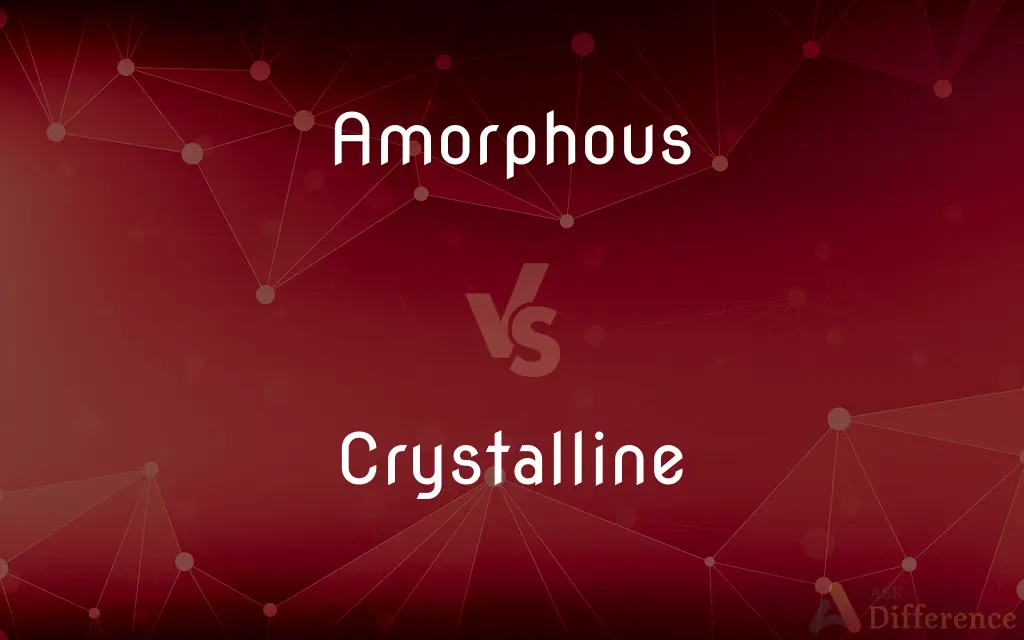Amorphous vs. Crystalline — What's the Difference?
By Tayyaba Rehman & Fiza Rafique — Updated on April 17, 2024
Amorphous substances lack a well-defined structure, making them less rigid, while crystalline substances are highly ordered, contributing to their strength and stability.

Difference Between Amorphous and Crystalline
Table of Contents
ADVERTISEMENT
Key Differences
Amorphous materials do not have a long-range, periodic atomic arrangement, which generally leads to more flexibility and deformability under external forces. On the other hand, crystalline materials possess a highly organized structure, where atoms are arranged in a repeating pattern that extends throughout the material. This structure gives crystalline substances their characteristic hardness and brittleness.
In terms of their thermal properties, amorphous substances often exhibit a gradual softening with increasing temperature, leading up to a broad glass transition range. Whereas crystalline materials have a sharp melting point at which they transition quickly from solid to liquid. This difference is crucial in applications requiring high precision in melting and solidification processes, such as metallurgy and polymer manufacturing.
Amorphous substances typically allow light to pass through without significant scattering, resulting in materials that can be transparent or translucent. Crystalline materials, however, may exhibit varied optical properties depending on the arrangement of their atoms; they can be either transparent, translucent, or opaque.
Regarding solubility, amorphous solids are generally more soluble in solvents than their crystalline counterparts because their disordered structure allows more interaction with the solvent molecules. Crystalline solids resist dissolving due to their tightly packed atoms which are difficult for the solvent molecules to penetrate.
In the pharmaceutical industry, the distinction between amorphous and crystalline forms of a drug can significantly impact its bioavailability. Amorphous drugs typically dissolve faster and are more bioavailable than their crystalline forms, which is crucial for the effectiveness of the drug.
ADVERTISEMENT
Comparison Chart
Structural Order
Lacks long-range order
Highly ordered, periodic arrangement
Mechanical Properties
More flexible and deformable
Hard and brittle
Thermal Behavior
Broad glass transition range
Sharp melting point
Optical Properties
Generally transparent or translucent
Can vary widely (transparent to opaque)
Solubility
Generally higher solubility
Generally lower solubility
Compare with Definitions
Amorphous
Describing a solid that lacks crystalline periodicity.
Amorphous silicon is used in thin-film solar cells.
Crystalline
Composed of crystals.
The crystalline rock glistened under the microscope.
Amorphous
Vaguely formed or ill-organized.
The plan was amorphous and lacked any coherent structure.
Crystalline
Having the structure and form of a crystal; lattice-like.
The crystalline structure of diamond makes it extremely hard.
Amorphous
Not clearly categorized or classified.
His music belongs to an amorphous genre that blends jazz and hip-hop.
Crystalline
Marked by clarity or definiteness.
Her explanation was crystalline in its precision.
Amorphous
Lacking a clearly defined shape or form.
Amorphous blobs of paint were scattered across the canvas.
Crystalline
Clear, transparent, often implying purity.
The crystalline waters of the mountain lake were mesmerizing.
Amorphous
Freeform or shapeless.
The amorphous nature of the sculpture made it intriguing.
Crystalline
Related to or denoting materials with a crystal structure.
Crystalline semiconductors are essential in electronics.
Amorphous
Lacking physical form or shape.
Crystalline
Being, relating to, or composed of crystal or crystals.
Amorphous
Lacking organization; formless
"He helped me turn a deeply felt but amorphous idea into a coherent narrative" (James S. Hirsch).
Crystalline
Resembling crystal, as in transparency or distinctness of structure or outline.
Amorphous
Lacking a crystalline structure
Glass is an amorphous material.
Crystalline
Of, relating to, or composed of crystals.
Amorphous
Lacking a definite form or clear shape.
The enormous pile of spaghetti landed on the floor in an amorphous heap.
Crystalline
(chemistry) Having a regular three-dimensional molecular structure.
Amorphous
(by extension) Being without definite character or nature.
Crystalline
Resembling crystal in being clear and transparent.
Amorphous
(by extension) Lacking organization or unity.
Crystalline
Pure.
Amorphous
(physics) In the non-crystalline solid state of a typically crystalline solid.
Crystalline
(obsolete) Any crystalline substance.
Amorphous
Infinite and not the disjoint union of two infinite subsets.
Crystalline
(obsolete) aniline
Amorphous
Having no determinate form; of irregular; shapeless.
Crystalline
Consisting, or made, of crystal.
Mount, eagle, to my palace crystalline.
Amorphous
Without crystallization in the ultimate texture of a solid substance; uncrystallized.
Crystalline
Formed by crystallization; like crystal in texture.
Their crystalline structure.
Amorphous
Of no particular kind or character; anomalous.
Scientific treatises . . . are not seldom rude and amorphous in style.
Crystalline
Imperfectly crystallized; as, granite is only crystalline, while quartz crystal is perfectly crystallized.
Amorphous
Having no definite form or distinct shape;
Amorphous clouds of insects
An aggregate of formless particles
A shapeless mass of protoplasm
Crystalline
Fig.: Resembling crystal; pure; transparent; pellucid.
Amorphous
Lacking the system or structure characteristic of living bodies
Crystalline
A crystalline substance.
Amorphous
Without real or apparent crystalline form;
An amorphous mineral
Amorphous structure
Crystalline
See Aniline.
Crystalline
Consisting of or containing or of the nature of crystals;
Granite is crystalline
Crystalline
Distinctly or sharply outlined;
Crystalline sharpness of outline
Crystalline
Transmitting light; able to be seen through with clarity;
The cold crystalline water of melted snow
Crystal clear skies
Could see the sand on the bottom of the limpid pool
Lucid air
A pellucid brook
Transparent cristal
Common Curiosities
What are the typical properties of crystalline materials?
Crystalline materials typically exhibit hardness, a sharp melting point, and often have clear, defined forms.
In what applications might you prefer an amorphous material over a crystalline one?
Amorphous materials are often preferred in applications where flexibility and gradual thermal properties are beneficial, such as in polymers and glasses.
How do amorphous and crystalline materials differ in their optical properties?
Amorphous materials are generally transparent or translucent, while crystalline materials can range from transparent to opaque depending on their atomic arrangement.
What defines an amorphous structure?
An amorphous structure is defined by a lack of long-range order or periodicity in its atomic arrangement.
What role does crystallinity play in the pharmaceutical industry?
Crystallinity can significantly affect the solubility and bioavailability of drugs, influencing their effectiveness.
How does the lack of order in amorphous materials affect their mechanical properties?
The lack of order makes amorphous materials more flexible and less brittle compared to crystalline materials.
What is the significance of a glass transition in amorphous materials?
The glass transition indicates a range of temperatures where amorphous materials transition from a hard and relatively brittle state to a more plastic and flexible state.
What are some examples of crystalline materials?
Examples include diamond, table salt, and quartz.
What impact does the structure of amorphous materials have on their use in solar cells?
The structure of amorphous materials like amorphous silicon allows for better absorption of solar energy, making them suitable for thin-film solar cells.
Can crystalline materials be amorphous?
No, crystalline materials cannot be amorphous as these terms are mutually exclusive based on the atomic arrangement.
How does clarity differ between amorphous and crystalline materials?
Amorphous materials generally maintain consistent clarity, whereas the clarity of crystalline materials can vary based on their internal crystal structures.
What makes crystalline structures ideal for electronic components?
The orderly arrangement of atoms in crystalline structures facilitates predictable electronic behaviors, making them ideal for components like semiconductors.
Are all amorphous materials flexible?
While not all amorphous materials are flexible, they generally exhibit more flexibility than crystalline materials due to their lack of a rigid, orderly structure.
Why are crystalline solids less soluble than amorphous solids?
The tightly packed and orderly structure of crystalline solids makes them less penetrable by solvent molecules, reducing their solubility.
How does the thermal behavior of amorphous and crystalline materials impact their manufacturing processes?
The broad transition range of amorphous materials allows for more forgiving manufacturing processes, while the sharp melting points of crystalline materials are critical for processes requiring precision.
Share Your Discovery

Previous Comparison
Jonquil vs. Daffodil
Next Comparison
Hangar vs. AirportAuthor Spotlight
Written by
Tayyaba RehmanTayyaba Rehman is a distinguished writer, currently serving as a primary contributor to askdifference.com. As a researcher in semantics and etymology, Tayyaba's passion for the complexity of languages and their distinctions has found a perfect home on the platform. Tayyaba delves into the intricacies of language, distinguishing between commonly confused words and phrases, thereby providing clarity for readers worldwide.
Co-written by
Fiza RafiqueFiza Rafique is a skilled content writer at AskDifference.com, where she meticulously refines and enhances written pieces. Drawing from her vast editorial expertise, Fiza ensures clarity, accuracy, and precision in every article. Passionate about language, she continually seeks to elevate the quality of content for readers worldwide.















































